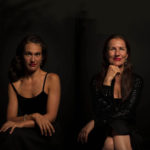«Unsere Leidenschaft für klassische Musik verbindet uns in großer Harmonie. Wir lieben die Einzigartigkeit der Kombination von Harfe und Klavier und deren fantastische Klangvielfalt.» – Duo Praxedis
«The Duo’s stated intent is to breathe new life into the thrilling partnership of harp and piano.» – International Piano Magazine
Das Duo Praxedis, die Harfenistin Praxedis Hug-Rütti und die Pianistin Praxedis Geneviève Hug, bezaubert seit Jahren das Publikum. Die Mission des Duo Praxedis ist die Renaissance der einst beliebten Duo-Besetzung Harfe & Klavier, die ihre Blüte von etwa 1780 bis ungefähr 1915 erlebte. Das Duo Praxedis gibt seit 2010 regelmässig und erfolgreich Konzerte in Europa und den USA.
Das Duo Praxedis hat bislang 12 von Publikum und Musikkritikern vielbeachtete Alben vorgelegt, darunter zwei Doppel-CDs nebst zahlreichen Ersteinspielungen. Die CD Histoires wurde für den OPUS KLASSIK 2019 in den Kategorien «Kammermusikeinspielung: Duo» und «Weltersteinspielung des Jahres» nominiert.
Das Duo gastierte auf Festivals wie dem Menuhin Festival Gstaad, dem Engadin-Festival, dem Esterhazy-Festival Eisenstadt oder dem Janáček-Festival sowie in Musikhochburgen wie der Philharmonie Berlin, im Goldenen Saal des Musikvereins Wien, in der Laieszhalle Hamburg oder der Tonhalle Zürich.
Das Duo Praxedis begeistert mit einer enormen Repertoirevielfalt, die sie auf diesem Gebiet einzigartig macht. Das Spektrum reicht von Bach über Mozart bis zu Bernstein, Piazzolla und Vivaldi: Musik des Barock, der Klassik und der Romantik, in Originalkompositionen und Bearbeitungen für Harfe & Klavier, auch von beliebten Meisterwerken, bis hin zu regelmässigen Kompositionsaufträgen an zeitgenössische Komponisten. So entstanden neue Doppelkonzerte mit Orchester von Oliver Waespi und Carl Rütti, die das Duo Praxedis uraufgeführt hat. 2014 erhielt das Duo Praxis einen Projektbeitrag von der UBS Kulturstiftung.
Das Duo Praxedis betreibt intensive Quellenforschung und entdeckt viele Repertoireraritäten in Archiven und Bibliotheken. Tausende Werke wurden für diese Besetzung geschrieben. Die letzten namhaften Komponisten zum Ende der Blütezeit waren Debussy und Ravel. Die Duo-Besetzung Harfe & Klavier war in den aristokratischen und bürgerlichen Salons des 19. Jahrhunderts besonders beliebt.
Aber auch auf den Konzertbühnen traten führende Klaviervirtuosen mit bedeutenden Harfenvirtuosen auf, mit denen sie auch gemeinsam neue Werke schufen. So zum Beispiel der Pianist Johann Ladislaus Dussek (1760–1812) mit Johann Baptist Krumpholz (1742–1790), der Pianist Friedrich Kalkbrenner (1785–1849) mit François-Joseph Dizi (1780–1847) und der Pianist Carl Czerny (1791–1857) mit Elias Parish Alvars (1808–1849), der von Hector Berlioz als der „Liszt der Harfe!“ bezeichnet wurde.
Warum geriet diese Besetzung in Vergessenheit? Der Klavierbau hat die Harfe überflügelt, indem er die Instrumente beständig an die Anforderungen grosser Konzertsäle angepasst hat. Heutzutage ist die moderne Konzertharfe in der Lage, mit einem Konzertflügel standzuhalten und auch so wird diese Besetzung wieder möglich – eine Kombination von besonderer klanglicher Raffinesse.
Praxedis Geneviève Hug über die Duo-Besetzung Harfe & Klavier:
«Das Ziel unserer Duo-Tätigkeit besteht nebst dem Spassfaktor und der gegenseitigen Interpretationsfreude darin, diese wunderschöne Besetzung, welche zur Zeit der Vorklassik bis 1915 sehr beliebt war, wiederaufleben zu lassen.
Zudem wollen wir mit den Entdeckungen von Originalwerken aufzeigen, dass die Kombination einerseits tatsächlich Inspirationsquelle namhafter Komponisten war, andererseits sollen die CD-Ersteinspielungen ein Vermächtnis an die Nachwelt darstellen, denn die wenigsten Werke für Harfe & Klavier wurden jemals aufgenommen.
Diese Marktlücke möchten wir ausfüllen, dazu mit eigens geschaffenen Bearbeitungen bekannter Meisterwerke die Instrumente als Duo für die grossen Konzerthäuser ʻkonzerttauglichʼ machen, damit man mit gekannten Melodien hört, wie facettenreich und doch symbiotisch die Instrumentation ist.
Im Laufe der Zeit fand ich heraus, dass unzählige und völlig unbekannte Werke in Bibliotheken schlummern, die nur über viele Umwege bestellbar sind. Allmählich lernte ich die Namen damals bekannter Künstler kennen und recherchierte, dass tatsächlich die meisten ein grosses Repertoire für Harfe & Klavier komponiert hatten. Zum Beispiel John Thomas, François-Joseph Naderman, François-Adrien Boieldieu und Charles Oberthür als Harfenisten sowie Friedrich Kalkbrenner, Johann Ladislaus Dussek und Carl Czerny als Pianisten.
Die Menge an existierenden Originalwerken erlaubt zahllose CD-Produktionen mit Ersteinspielungen, abgesehen von unseren eigenen Bearbeitungen sowie den Kompositionsaufträgen. Es ist faszinierend für uns herauszufinden, dass es vor vielen Jahren bereits bestehende Duos dieser Art gab und diese in allen wichtigen Hauptstädten Europas erfolgreich Konzerte gaben.
Harfe & Klavier passen wunderbar zusammen – vielleicht ja auch, weil ein Flügel, wenn man genau hinsieht, die Form einer umgekippten Harfe hat. Die Klanglichkeit der beiden Instrumente verschmilzt zu einem Instrument, obwohl beider Klang verschieden ist.»
